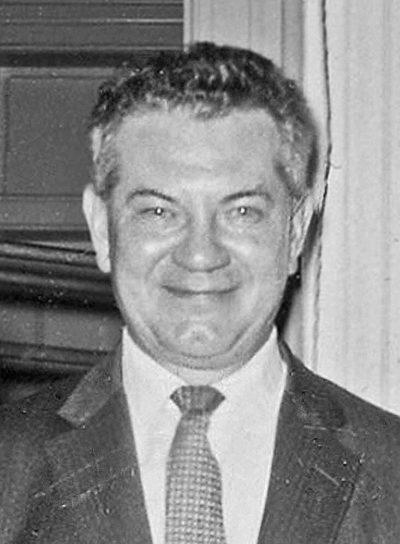Otto Binder (Otto Oscar Binder)

Otto Binder entered comics in 1939 on the heels of his artist brother, Jack, who moved to New York to work at the studio of Harry “A” Chesler, one of that era’s “packagers” who provided outsourced content for publishers entering the new medium of comic books. The following year, magazine publisher Fawcett Publications began its Fawcett Comics line, and Binder started writing the exploits of such characters as Captain Venture, Golden Arrow, Bulletman and El Carim. After a year, editor Ed Herron had Binder tackle Fawcett’s most prominent character, the superhero Captain Marvel. He soon wrote for the spin-off features starring Captain Marvel, Jr. and Mary Marvel, the latter of whom he co-created with Marc Swayze. Otto Binder spent from 1941 to 1953 with Fawcett, writing “986 stories … out of 1,743, over half the entire Marvel Family saga”, per comic-book writer-editor E. Nelson Bridwell. His first Captain Marvel writing was the “Dime Action Book” novel Return of the Scorpion, featuring the villain from the 1941 Republic serial The Adventures of Captain Marvel. His first Captain Marvel comic-book story was “Captain Marvel Saves the King” in Captain Marvel Adventures #9 (April 1942). He wrote for numerous other Fawcett features, as well as many two-page text fillers that were required in comics in order to be eligible for magazine postal rates. His text stories in Captain Marvel Adventures, under the “Eando” pseudonym, starred Lieutenant Jon Jarl of the Space Patrol. During his time at Fawcell, Binder co-created with Swayze and C. C. Beck such characters as Mary Marvel, Uncle Dudley, Mr. Tawky Tawny, Black Adam and Mr. Mind, as well as two of Doctor Sivana’s four children: the evil teens Thaddeus Sivana Jr. and daughter Georgia. Otto Binder and Beck unsuccessfully attempted to launch a newspaper comic strip featuring Mr. Tawky Tawny in 1953.
Otto Binder left Fawcett when the company shut down its comic book division in 1953, but found no shortage of work. For Timely Comics, the 1940s company that would evolve into Marvel Comics, he [co-]created Captain Wonder, the Young Allies, Tommy Tyme and the patriotically themed superheroine Miss America, and wrote for stories starring Captain America, the Human Torch, the Sub-Mariner, the Destroyer, the Whizzer, and the All-Winners Squad. For Quality Comics, Binder co-created Kid Eternity, and wrote Blackhawk, Doll Man, Uncle Sam’ and Black Condor stories. For MLJ Comics (subsequently known as Archie Comics), he wrote stories starring Steel Sterling, the Shield, the Hangman, and the Black Hood. At Gold Key Comics, Binder co-created Mighty Samson and other characters. His science fiction for EC Comics includes “Lost in Space”, illustrated by Al Williamson, in Weird Science-Fantasy #28 (March–April 1955). In 1948, Binder began working for DC Comics, then known as National Periodical Publications, swiftly creating Merry, Girl of 1,000 Gimmicks, in the feature “Star-Spangled Kid”, whose place Merry soon took in Star-Spangled Comics. He then moved on to his best-known DC work, the Superman group of titles, including launching the Superman’s Pal Jimmy Olsen series in 1954. Otto Binder and artist Al Plastino collaborated on the Superboy story in Adventure Comics #247 (April 1958) that introduced the Legion of Super-Heroes, a teen superhero team from the future that eventually became one of DC’s most popular features. Otto Binder and Plastino debuted the supervillain Brainiac and the Bottle City of Kandor in Action Comics #242 (July 1958) and co-created Supergirl in Action Comics #252 (May 1959). With various artist collaborators, he co-created Krypto the Super Dog, the Phantom Zone, and the supporting characters Lucy Lane, Beppo the Super Monkey, and Titano the Super Ape. In the first issue of Superman’s Pal Jimmy Olsen, he introduced Jimmy Olsen’s signal-watch, and in #31, Jimmy’s Elastic Lad identity. He wrote the Lois Lane feature in Showcase #9 (Aug. 1957) which served as a tryout for the character’s own series.
DC writer-editor E. Nelson Bridwell credits Binder as creating the first “Imaginary Tale, for Lois Lane,” and of writing “most of the early” Bizarro stories, including at least the first “Tales of the Bizarro World” feature. The character’s first comic book appearance was in Superboy #68 (Oct. 1958) by Binder and artist George Papp and Bizarro World was introduced in Action Comics #263 (April 1960). Binder scripted what Bridwell calls the “classic [storyline] ‘Superman’s Return to Krypton.'” His last Superman story was “The Cage of Doom” in Action Comics #377 (June 1969). Otto Binder was featured in a story in the first issue of Shazam, DC Comics’ 1970s revival of the original Captain Marvel. The Binder character, drawn by C. C. Beck, meets a young Billy Batson and is astonished that the boy, who has been missing for 20 years, is still a kid. He died in Chestertown, New York on October 13, 1974.
Born
- August, 26, 1911
- USA
- Bessemer, Michigan
Died
- October, 13, 1974
- USA
- Charlestown, New York

